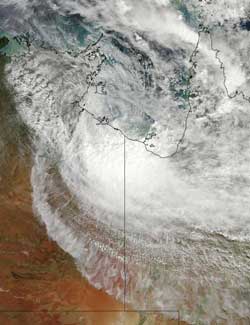Warnings dropped for ex-cyclone Paul as NASA satellites see it fizzle

The MODIS instrument on NASA\'s Aqua satellite captured a visible image of the remnants of Cyclone Paul over the Gulf of Carpentaria, Australia at 04:45 UTC (12:45 a.m. EDT) today, April 1, 2010. Credit: NASA MODIS Rapid Response Team<br>
The Moderate Resolution Imaging Spectroradiometer or MODIS instrument on NASA's Aqua satellite captured a visible image of the remnants of Cyclone Paul over the Gulf of Carpentaria, Australia at 04:45 UTC (12:45 a.m. EDT) today, April 1, 2010. The image showed that most of the clouds associated with the low were on the southern side of the circulation and over land.
Another instrument on NASA's Aqua satellite also got a good look at Paul's remnants as the satellite flew overhead. The Atmospheric Infrared Sounder, or AIRS instrument captured an infrared image of Paul's cold remnant thunderstorm cloud tops. The infrared image, which shows temperatures, indicated that the strongest thunderstorms were still over land in the Northern Territory. The image also showed very warm land to Paul's west and south.
The only warnings in effect are for the coastal waters, where there is a wind warning posted from Coastal Nhulunbuy to the Queensland border. The warning means that winds from the west-southwest will be gusting to 20-30 knots (23- 34 mph/ 37-55 kph), easing below 25 knots (28 mph/46 kph) during Friday morning (local Darwin time). Seas are expected to be as high as 3 meters (9 feet), but the conditions are expected to ease on Friday.
On April 1 at 11:15 p.m. CST Darwin time (8:45 a.m. EDT) Paul's remnants were located close to the Northern Territory/Queensland border in the southern Gulf of Carpentaria coast. The low is expected to track inland overnight and continue to weaken over the southern Top End during the next few days.
Paul is now not expected to redevelop into a tropical cyclone.
Media Contact
More Information:
http://www.nasa.govAll latest news from the category: Earth Sciences
Earth Sciences (also referred to as Geosciences), which deals with basic issues surrounding our planet, plays a vital role in the area of energy and raw materials supply.
Earth Sciences comprises subjects such as geology, geography, geological informatics, paleontology, mineralogy, petrography, crystallography, geophysics, geodesy, glaciology, cartography, photogrammetry, meteorology and seismology, early-warning systems, earthquake research and polar research.
Newest articles

Superradiant atoms could push the boundaries of how precisely time can be measured
Superradiant atoms can help us measure time more precisely than ever. In a new study, researchers from the University of Copenhagen present a new method for measuring the time interval,…

Ion thermoelectric conversion devices for near room temperature
The electrode sheet of the thermoelectric device consists of ionic hydrogel, which is sandwiched between the electrodes to form, and the Prussian blue on the electrode undergoes a redox reaction…

Zap Energy achieves 37-million-degree temperatures in a compact device
New publication reports record electron temperatures for a small-scale, sheared-flow-stabilized Z-pinch fusion device. In the nine decades since humans first produced fusion reactions, only a few fusion technologies have demonstrated…





















